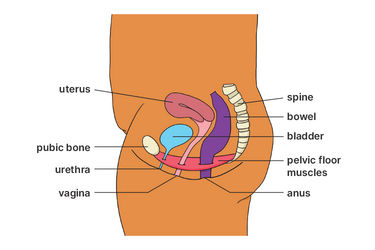When learning about good bladder health, it’s helpful to know how the bladder and pelvic floor muscles work.
The bladder is an organ in your body that stores wee (urine) until you’re ready to go to the toilet.
It’s supported by a group of muscles called the ‘pelvic floor’. These muscles help you ‘hold on’ until you get to a toilet. They also help to keep the bladder in its normal position in the pelvis. Pelvic floor muscles must relax for you to wee.

The pelvic floor is made up of muscles and tissues that run from your pubic bone at the front of your pelvis to your tailbone (coccyx) at the bottom of your spine. It also expands from one sitting bone to the other. These muscles are like a supportive hammock for your bladder, bowel and uterus.
Your pelvic floor muscles are part of a muscle group known as your ‘core’. Your core muscles also include your deep abdominal and back muscles. Together with the pelvic floor muscles, they support your spine and control the pressure in your abdomen.
Your pelvic floor muscles:
Watch this Continence Health Australia video about pelvic floor muscles.
Read more about your pelvic floor muscles.
Pelvic floor muscles may become weaker for a variety of reasons. For example:
The muscles may also become weaker due to:
If you have weak pelvic floor muscles, you may experience:
Tight (overactive) pelvic floor muscles can cause health problems such as constipation, painful sex and pelvic pain. They can also cause tension in the hip and pelvis muscles.
In Australia, one in three women have a bladder control problem. It’s important to do pelvic floor exercises to maintain strong pelvic floor muscles and prevent bladder and bowel problems throughout your life.
Pelvic floor exercises benefit people of all ages, but they are especially important during pregnancy, after childbirth and after menopause when pelvic floor muscles weaken.
You can see a pelvic floor physiotherapist if you are unsure about how to do the exercises, you continue to have symptoms or symptoms worsen.
To find a pelvic floor physiotherapist, go to the Find a physio webpage on the Australian Physiotherapy Association website. Under ‘Refine your search’ choose ‘Special interest area: Women’s, Men’s and Pelvic health’.
Start by finding the muscles you need to exercise.
Move into a comfortable position. You can start by lying on your back (on a bed, couch or floor) with your knees bent. You can also try sitting with a straight back, leaning slightly forwards.
Squeeze (quickly and strongly) the muscles around your anus, vagina and urethra. Lift and draw these muscles up and forwards towards your belly button, then let go. Try not to squeeze your bottom.
You can also imagine trying to stop weeing. Then relax as if you are weeing again.
Once you can feel your pelvic floor muscles, you can focus on strengthening them.
It’s important to do the exercises the right way. Visit the Continence Health Australia website to learn more about how to exercise your pelvic floor muscles. You can also download the handy fact sheet.
Listen to a podcast about pelvic floor exercises.
Note that pelvic floor strengthening exercises are not suitable for everyone. If you experience vaginal or pelvic pain, you may need a special program to learn how to relax your pelvic floor muscles.
You can help your pelvic floor muscles by:
You can also:
This content has been reviewed by a group of medical subject matter experts, in accordance with Jean Hailes policy. It has been produced in partnership with Continence Health Australia.
© Jean Hailes Foundation. All rights reserved.